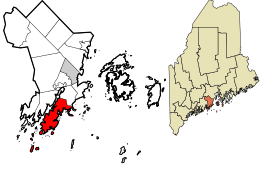St. George, Maine
| St. George, Maine | |
|---|---|
| Town | |
 Location in Knox County and the state of Maine. |
|
| Coordinates: 44°00′59″N 69°11′56″W / 44.0164709°N 69.1989341°WCoordinates: 44°00′59″N 69°11′56″W / 44.0164709°N 69.1989341°W | |
| Country | United States |
| State | Maine |
| County | Knox |
| Incorporated | February 7, 1803 |
| Area | |
| • Total | 117.25 sq mi (303.68 km2) |
| • Land | 25.02 sq mi (64.80 km2) |
| • Water | 92.23 sq mi (238.87 km2) |
| Population (2010) | |
| • Total | 2,591 |
| • Estimate (2012) | 2,592 |
| • Density | 103.6/sq mi (40.0/km2) |
| Time zone | Eastern (EST) (UTC-5) |
| • Summer (DST) | EDT (UTC-4) |
St. George is a town in Knox County, Maine, United States. The population was 2,591 at the 2010 Census. It includes the villages of Port Clyde, Clark Island, Glenmere, Martinsville and Tenants Harbor, the latter its commercial center. A favorite with artists, writers and naturalists, St. George is home to the Brothers and Hay Ledge nature preserve, comprising four islands off Port Clyde.
The peninsula and its islands were noted for immense flocks of duck, geese and other waterfowl. Although the region was part of the Waldo Patent, General Samuel Waldo complied with requests from Abenaki Indians not to settle immigrants at what was their prized hunting ground. Consequently, the peninsula remained unpopulated until after the close of the French and Indian Wars in 1763. The Revolutionary War further slowed development, but during the 1780s, there was rapid settlement of the peninsula. It was incorporated in 1789 as part of Cushing. On February 7, 1803, the peninsula and its islands were set off and incorporated as St. George, taking its name from the river.
Farmers grew potatoes. After 1830, granite was quarried and shipped nationally for construction. Shipbuilders annually produced three to four vessels, many for the coasting trade, exporting cordwood, lumber and fish. Factories canned lobsters, clams and sardines. In the 1880s, the town's rugged oceanfront beauty was discovered by "rusticators"—visitors, including artists, who bought or built summer cottages.
...
Wikipedia
